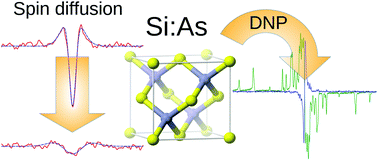Dynamic nuclear polarization and ESR hole burning in As doped silicon
Abstract
We present an experimental study of the Dynamic Nuclear Polarization (DNP) of 29Si nuclei in silicon crystals of natural abundance doped with As in the temperature range 0.1–1 K and in a strong magnetic field of 4.6 T. This ensures a very high degree of electron spin polarization, extremely slow nuclear relaxation and optimal conditions for realization of Overhauser and resolved solid effects. We found that the solid effect DNP leads to the appearance of a pattern of holes and peaks in the ESR line, separated by the super-hyperfine interaction between the donor electron and 29Si nuclei closest to the donor. On the contrary, the Overhauser effect DNP mainly affects the remote 29Si nuclei having the weakest interaction with the donor electron. This leads to the appearance of a very narrow (≈3 mG wide) hole in the ESR line. We studied relaxation of the holes after burning, which is caused by the nuclear spin diffusion. Analyzing the dynamics of the hole in the spectrum with a simple one-dimensional diffusion model leads to a value of the diffusion coefficient D = 8(3) × 10−9 G2 s−1. Our data indicate that the spin diffusion is not completely prevented even in the frozen core near the donors. The emergence of the narrow hole after the Overhauser DNP may be explained by a partial “softening” of the frozen core caused by decoupling of the donor electron and remote 29Si nuclei.



 Please wait while we load your content...
Please wait while we load your content...